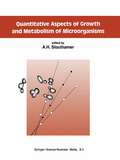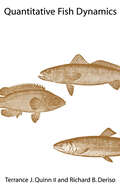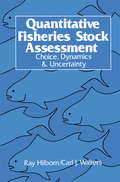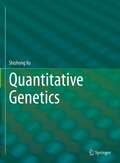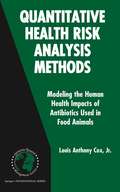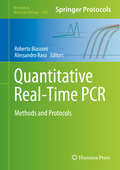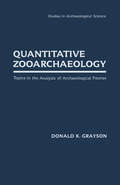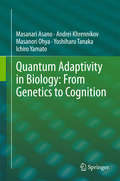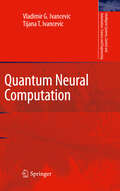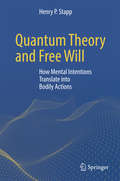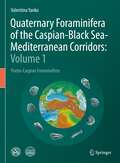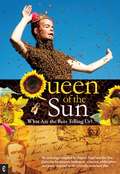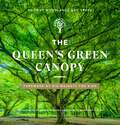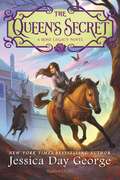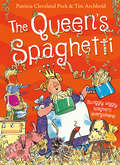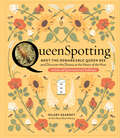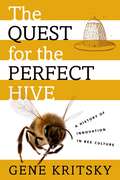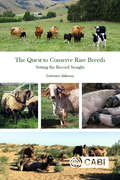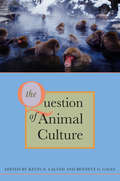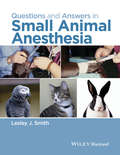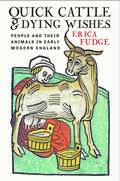- Table View
- List View
Quantitative Aspects of Growth and Metabolism of Microorganisms
by A. H. StouthamerApplication of recent advances, such as non-equilibrium thermodynamics, the maintenance concept and the material balancing method, to the description, of microbial growth has suggested new experimental approaches which have yielded a wealth of data. These data have been used to develop mathematical models of microbial growth and metabolism, and the models have made it possible to direct the metabolism of a microorganism in such a way that more of a certain desired product is made. While a full quantitative description of all aspects of microbial growth and metabolism is till remote, the new approaches are opening up large areas of new potential -- it is now possible, for instance, to deal with individual cells in a population and with quantitative aspects of product formation and optimisation. Microbiologists, biochemists and physiologists will find this an invaluable update on a field of great promise.
Quantitative Fish Dynamics (Biological Resource Management)
by Terrance J. Quinn Richard B. DerisoThis book serves as an advanced text on fisheries and fishery population dynamics and as a reference for fisheries scientists. It provides a thorough treatment of contemporary topics in quantitative fisheries science and emphasizes the link between biology and theory by explaining the assumptions inherent in the quantitative methods. The analytical methods are accessible to a wide range of biologists, and the book includes numerous examples. The book is unique in covering such advanced topics as optimal harvesting, migratory stocks, age-structured models, and size models.
Quantitative Fish Dynamics (Biological Resource Management)
by Terrance J. Quinn Richard B. DerisoThis book serves as an advanced text on fisheries and fishery population dynamics and as a reference for fisheries scientists. It provides a thorough treatment of contemporary topics in quantitative fisheries science and emphasizes the link between biology and theory by explaining the assumptions inherent in the quantitative methods. The analytical methods are accessible to a wide range of biologists, and the book includes numerous examples. The book is unique in covering such advanced topics as optimal harvesting, migratory stocks, age-structured models, and size models.
Quantitative Fisheries Stock Assessment: Choice, Dynamics and Uncertainty
by R. Hilborn C. J. WaltersThis book really began in 1980 with our first microcomputer, an Apple II +. The great value of the Apple II + was that we could take the computer programs we had been building on mainframe and mini-computers, and make them available to the many fisheries biologists who also had Apple II + 's. About 6 months after we got our first Apple, John Glaister came through Vancouver and saw what we were doing and realized that his agency (New South Wales State Fisheries) had the same equipment and could run the same programs. John organized a training course in Australia where we showed about 25 Australian fisheries biologists how to use microcomputers to do many standard fisheries analyses. In the process of organizing this and sub sequent courses we developed a series of lecture notes. Over the last 10 years these notes have evolved into the chapters of this book.
Quantitative Genetics
by Shizhong XuThe intended audience of this textbook are plant and animal breeders, upper-level undergraduate and graduate students in biological and agricultural science majors. Statisticians who are interested in understanding how statistical methods are applied to genetics and agriculture can benefit substantially by reading this book. One characteristic of this textbook is represented by three chapters of technical reviews for Mendelian genetics, population genetics and preliminary statistics, which are prerequisites for studying quantitative genetics. Numerous examples are provided to illustrate different methods of data analysis and estimation of genetic parameters. Along with each example of data analyses is the program code of SAS (statistical analysis system).
Quantitative Health Risk Analysis Methods: Modeling the Human Health Impacts of Antibiotics Used in Food Animals (International Series in Operations Research & Management Science #82)
by Louis Anthony Cox Jr.This book grew out of an effort to salvage a potentially useful idea for greatly simplifying traditional quantitative risk assessments of the human health consequences of using antibiotics in food animals. In 2001, the United States FDA’s Center for Veterinary Medicine (CVM) (FDA-CVM, 2001) published a risk assessment model for potential adverse human health consequences of using a certain class of antibiotics, fluoroquinolones, to treat flocks of chickens with fatal respiratory disease caused by infectious bacteria. CVM’s concern was that fluoroquinolones are also used in human medicine, raising the possibility that fluoroquinolone-resistant strains of bacteria selected by use of fluoroquinolones in chickens might infect humans and then prove resistant to treatment with human medicines in the same class of antibiotics, such as ciprofloxacin. As a foundation for its risk assessment model, CVM proposed a dramatically simple approach that skipped many of the steps in traditional risk assessment. The basic idea was to assume that human health risks were directly proportional to some suitably defined exposure metric. In symbols: Risk = K × Exposure, where “Exposure” would be defined in terms of a metric such as total production of chicken contaminated with fluoroquinolone-resistant bacteria that might cause human illnesses, and “Risk” would describe the expected number of cases per year of human illness due to fluoroquinolone-resistant bacterial infections caused by chicken and treated with fluoroquinolones.
Quantitative Real-Time PCR: Methods and Protocols (Methods in Molecular Biology #1160)
by Roberto Biassoni and Alessandro RasoQuantitative Real-Time PCR: Methods and Protocols focuses on different applications of qPCR ranging from microbiological detections (both viral and bacterial) to pathological applications. Several chapters deal with quality issues which regard the quality of starting material, the knowledge of the minimal information required to both perform an assay and to set the experimental plan, while the others focus on translational medicine applications that are ordered following an approximate logical order of their medical application. The last part of the book gives you an idea of an emerging digital PCR technique that is a unique qPCR approach for measuring nucleic acid, particularly suited for low level detection and to develop non-invasive diagnosis. Written for the Methods in Molecular Biology series, most chapters include introductions to their respective topics, lists of the necessary materials and reagents, step-by-step, laboratory protocols and tips on troubleshooting and avoiding known pitfalls.Practical and authoritative, Quantitative Real-Time PCR: Methods and Protocols aims to aid researchers seeking to devise new qPCR-based approaches related to his or her area of investigation.
Quantitative Zooarchaeology: Topics in the Analysis of Archaelogical Faunas (Studies in Archaeology)
by Donald K. GraysonQuantitative Zooarchaeology
Quantum Adaptivity in Biology: From Genetics to Cognition
by Masanari Asano Andrei Khrennikov Masanori Ohya Yoshiharu Tanaka Ichiro YamatoThis book examines information processing performed by bio-systems at all scales: from genomes, cells and proteins to cognitive and even social systems. It introduces a theoretical/conceptual principle based on quantum information and non-Kolmogorov probability theory to explain information processing phenomena in biology as a whole.The book begins with an introduction followed by two chapters devoted to fundamentals, one covering classical and quantum probability, which also contains a brief introduction to quantum formalism, and another on an information approach to molecular biology, genetics and epigenetics. It then goes on to examine adaptive dynamics, including applications to biology, and non-Kolmogorov probability theory.Next, the book discusses the possibility to apply the quantum formalism to model biological evolution, especially at the cellular level: genetic and epigenetic evolutions. It also presents a model of the epigenetic cellular evolution based on the mathematical formalism of open quantum systems. The last two chapters of the book explore foundational problems of quantum mechanics and demonstrate the power of usage of positive operator valued measures (POVMs) in biological science.This book will appeal to a diverse group of readers including experts in biology, cognitive science, decision making, sociology, psychology, and physics; mathematicians working on problems of quantum probability and information and researchers in quantum foundations.
Quantum Neural Computation (Intelligent Systems, Control and Automation: Science and Engineering #40)
by Vladimir G. Ivancevic Tijana T. IvancevicQuantum Neural Computation is a graduate–level monographic textbook. It presents a comprehensive introduction, both non-technical and technical, into modern quantum neural computation, the science behind the fiction movie Stealth. Classical computing systems perform classical computations (i.e., Boolean operations, such as AND, OR, NOT gates) using devices that can be described classically (e.g., MOSFETs). On the other hand, quantum computing systems perform classical computations using quantum devices (quantum dots), that is devices that can be described only using quantum mechanics. Any information transfer between such computing systems involves a state measurement. This book describes this information transfer at the edge of classical and quantum chaos and turbulence, where mysterious quantum-mechanical linearity meets even more mysterious brain’s nonlinear complexity, in order to perform a super–high–speed and error–free computations. This monograph describes a crossroad between quantum field theory, brain science and computational intelligence.
Quantum Theory and Free Will: How Mental Intentions Translate into Bodily Actions
by Henry P. StappThis book explains, in simple but accurate terms, how orthodox quantum mechanics works. The author, a distinguished theoretical physicist, shows how this theory, realistically interpreted, assigns an important role to our conscious free choices. Stapp claims that mainstream biology and neuroscience, despite nearly a century of quantum physics, still stick essentially to failed classical precepts in which mental intentions have no effect upon our bodily actions. He shows how quantum mechanics provides a rational basis for a better understanding of this connection, even allowing an explanation of certain phenomena currently held to be “paranormal”. These ideas have major implications for our understanding of ourselves and our mental processes, and thus also for the meaningfulness of our lives.
Quaternary Foraminifera of the Caspian-Black Sea-Mediterranean Corridors: Ponto-Caspian Foraminifera
by Valentina YankoThis handbook in two volumes offers a heretofore unavailable compilation of detailed information on foraminifera of the Caspian-Black Sea-Mediterranean Corridors (“CORRIDORS”), including their taxonomy, ecology, and applications in the study of Quaternary stratigraphy, paleogeographic reconstruction, and environmental stress. This subject is significant in light of the ongoing debates regarding the Flood Hypotheses because foraminifera can provide more information about many of the disputed questions. Foraminifera are highly reliable paleoenvironmental indicators, ubiquitous in marine environments, and taxonomically diverse, which gives them the potential for a wide range of biological responses to varied environmental factors. Their tests are readily preserved and can record evidence of environmental change through time, thus providing historical baseline data even in the absence of background studies. This book presents taxonomic descriptions for about 500 species and subspecies from the Black Sea, Sea of Azov, Caspian Sea, Aral Sea, Sea of Marmara, and the Eastern Mediterranean. This catalogue is supplemented by ecological remarks, stratigraphic distributions, paleogeography, and environmental/paleoenvironmental applications, including responses to environmental stress, e.g., river discharge, pollution by different contaminants, etc. The book will be useful to specialists in Quaternary history of the “CORRIDORS” as well as those in environmental monitoring and risk assessment. This handbook offers detailed taxonomic descriptions of foraminifera from the Black Sea, Caspian Sea, Sea of Azov, Aral Sea (in Volume 1) and Eastern Mediterranean and Sea of Marmara (in Volume 2).
Queen of the Sun: What are the Bees Telling Us?
by Taggart SiegelIn Autumn 2006 an unnerving phenomenon hit the United States: honeybees were mysteriously disappearing from hives across the nation, with beekeepers reporting losses of between 30 and 90 per cent of their entire colonies. The problem soon spread to parts of Europe and even Asia, earning the name Colony Collapse Disorder. To this day nobody is absolutely sure why it is happening and what the exact causes are. However, in 1923 Rudolf Steiner, a scientist, philosopher and social innovator, predicted that bees would die out within 100 years if they were to be reproduced using only artificial methods. Startlingly, and worryingly, his prediction appears to be coming true.Queen of The Sun, What Are the Bees Telling Us? is a companion book to the critically-acclaimed film of the same name. Compiled by the film’s director Taggart Siegel, it makes a profound examination of the global bee crisis through the eyes of biodynamic and organic beekeepers, scientists, farmers, philosophers and poets. Revealing the mysterious world of the beehive and the complex social community of bees, the book unveils millennia of beekeeping, highlighting our historic and sacred relationship with bees, and how this is being compromised by highly-mechanized and intensive agro-industrial practices. The bees are messengers and their disappearance is a resounding wake-up call for humanity!With full colour, stunning photography throughout, this engaging, alarming but ultimately uplifting anthology begins with an account of how Siegel’s film came to be made. It continues with a wealth of articles, interviews and poems that offer unique philosophical and spiritual insights. Besides investigating many contributory causes of Colony Collapse Disorder, the book offers remedies as well as hope for the future.Queen of the Sun features contributions from Taggart Siegel, Jon Betz, David Heath, Gunther Hauk, Horst Kornberger, Jennifer Kornberger, Jacqueline Freeman, Johannas Wirz, Kerry Grefig, Michael Thiele, Raj Patel, Vandana Shiva, Jeffery Smith and Matthew Barton. These compelling voices signal a growing movement striving to found a culture fully in balance with nature.
The Queen's Green Canopy: Ancient Woodlands and Trees
by Adrian Houston Charles Sainsbury-PlaiceStunning photographs of the United Kingdom's most spectacular trees - with a foreword by His Majesty the King.The Queen's Green Canopy is a beautiful photography book showcasing 70 ancient trees and 70 ancient woodlands dedicated by the QGC initiative in honour of Her Majesty's Platinum Jubilee.The book features extraordinary photographs of the United Kingdom's best-loved trees, many of which inspired historic figures, artists and writers through the centuries.Alongside these photographs are short written pieces from contributors including Dame Judi Dench, Alan Titchmarsh, Dame Joanna Lumley, Adam Henson, Archbishop Justin Welby and Danny Clarke, as well as conservation experts from the Woodland Trust and the Duchy of Cornwall. In these pieces they reflect on the trees that have made a mark on their lives and the importance of protecting Britain's woodlands for future generations.Selected trees include yews at a Cotswold's church which inspired JRR Tolkien; the apple tree believed to have inspired Sir Isaac Newton's theory of gravity; the Five Hundred Acre Wood in East Sussex immortalised in AA Milne's Winnie the Pooh books; and the 2,500-year-old tree where Henry VIII may have proposed to Anne Boleyn.So far 3 million trees have been planted by communities, schools and businesses across the country as part of the QGC initiative. Through incredible imagery and joyful pieces of writing, The Queen's Green Canopy celebrates Her Majesty's extraordinary life and the amazing legacy she leaves behind.
The Queen's Secret (Rose Legacy)
by Jessica Day GeorgeBestselling author Jessica Day George continues her heartfelt fantasy series about a girl who can communicate with horses and a kingdom on the brink of collapse. Anthea knows the truth about horses. They're not carriers of deadly disease like everyone in their kingdom thinks; they're majestic creatures who share their thoughts and feelings with her through The Way. Anthea has convinced the king of this, but at a cost--he demands that horses and riders with The Way do his bidding. But when a deadly plague breaks out, the people believe that horses are the cause. As more fall ill, it's up to Anthea and her friends to transport medicine, all while keeping out of reach from Anthea's wicked mother. And when Anthea discovers a secret that could change the kingdom forever, she must risk everything to reveal the truth before it's too late.Continuing the sweeping storytelling of The Rose Legacy, bestselling author Jessica Day George delights readers--especially horse lovers--once again.
QueenSpotting: Meet the Remarkable Queen Bee and Discover the Drama at the Heart of the Hive; Includes 48 Queenspotting Challenges
by Hilary KearneyPopular urban beekeeper Hilary Kearney challenges nature lovers, science fans, and beekeepers alike to &“spot the queen&” in 48 amazing fold-out photo challenges, accompanied by stories of the dramatic life of the queen honey bee and stories of swarm-capturing adventures.
The Quest for the Perfect Hive: A History of Innovation in Bee Culture
by Gene KritskyBeekeeping is a sixteen-billion-dollar-a-year business. But the invaluable honey bee now faces severe threats from diseases, mites, pesticides, and overwork, not to mention the mysterious Colony Collapse Disorder, which causes seemingly healthy bees to abandon their hives en masse, never to return. In The Quest for the Perfect Hive, entomologist Gene Kritsky offers a concise, beautifully illustrated history of beekeeping, tracing the evolution of hive design from ancient Egypt to the present. Not simply a descriptive account, the book suggests that beekeeping's long history may in fact contain clues to help beekeepers fight the decline in honey bee numbers. Kritsky guides us through the progression from early mud-based horizontal hives to the ascent of the simple straw skep (the inverted basket which has been in use for over 1,500 years), from hive design's Golden Age in Victorian England up through the present. He discusses what worked, what did not, and what we have forgotten about past hives that might help counter the menace to beekeeping today. Indeed, while we have sequenced the honey bee genome and advanced our knowledge of the insects themselves, we still keep our bees in hives that have changed little during the past century. If beekeeping is to survive, Kritsky argues, we must start inventing again. We must find the perfect hive for our times. For thousands of years, the honey bee has been a vital part of human culture. The Quest for the Perfect Hive not only offers a colorful account of this long history, but also provides a guide for ensuring its continuation into the future.
The Quest for the Perfect Hive: A History of Innovation in Bee Culture
by Gene KritskyBeekeeping is a sixteen-billion-dollar-a-year business. But the invaluable honey bee now faces severe threats from diseases, mites, pesticides, and overwork, not to mention the mysterious Colony Collapse Disorder, which causes seemingly healthy bees to abandon their hives en masse, never to return. In The Quest for the Perfect Hive, entomologist Gene Kritsky offers a concise, beautifully illustrated history of beekeeping, tracing the evolution of hive design from ancient Egypt to the present. Not simply a descriptive account, the book suggests that beekeeping's long history may in fact contain clues to help beekeepers fight the decline in honey bee numbers. Kritsky guides us through the progression from early mud-based horizontal hives to the ascent of the simple straw skep (the inverted basket which has been in use for over 1,500 years), from hive design's Golden Age in Victorian England up through the present. He discusses what worked, what did not, and what we have forgotten about past hives that might help counter the menace to beekeeping today. Indeed, while we have sequenced the honey bee genome and advanced our knowledge of the insects themselves, we still keep our bees in hives that have changed little during the past century. If beekeeping is to survive, Kritsky argues, we must start inventing again. We must find the perfect hive for our times. For thousands of years, the honey bee has been a vital part of human culture. The Quest for the Perfect Hive not only offers a colorful account of this long history, but also provides a guide for ensuring its continuation into the future.
The Quest to Conserve Rare Breeds: Setting the Record Straight
by Lawrence AldersonSince the middle of the twentieth century the world has witnessed a succession of political and social disruptions. Globalisation, technological advancement, climate change, human migration, war and conflict - all have caused major worldwide upheavals. In this light, it's unsurprising that conservation of rare breed animals has been neglected. Yet the preservation of these genetic resources - this biological diversity - is an essential ingredient of sustainable life on Earth, and not something we can afford to lose. This book challenges often repeated 'facts' about livestock farming, straight from the horse's mouth. In it, rare breeds expert Lawrence Alderson CBE argues for a reasoned and evidence-based approach from political and public circles. Correcting misconceptions as he goes, he recounts the creation and development of the rare breed conservation movement, addresses extinctions and genetic safe-guarding measures, and considers where we go from here. Challenged as we are by climate change, sustainability and feeding the world, perhaps it is these endangered animals that hold the answer - perhaps with them, we can adapt to our changing environment and see a way forward to a more certain future.
The Question Of Animal Culture
by Michael Tomasello Hal Whitehead Andrew Whiten Kim Hill Janet Mann W. C. McGrew Susan Perry Kim Sterelny Kevin Laland Carel Schaik Brooke Sargeant Rachel Kendal Bennett Galef Kristin Bonnie Jeremy KendalFifty years ago, a troop of Japanese macaques was observed washing sandy sweet potatoes in a stream, sending ripples through the fields of ethology, comparative psychology, and cultural anthropology. The issue of animal culture has been hotly debated ever since. Now Kevin Laland and Bennett Galef have gathered key voices in the often rancorous debate to summarize the views along the continuum from "Culture? Of course!" to "Culture? Of course not!" The result is essential reading for anyone interested in the validity of animal culture, and what it might say about our own.
Questions and Answers about: Animal World
by Arcturus PublishingAnimal World is packed full of amazing images & fascinating facts about the magnificent creatures that inhabit the earth. Explore the great diversity of the animal kingdom, from lions to lizards, & elephants to eagles. Readers can look forward to learning about them all!
Questions and Answers in Small Animal Anesthesia
by Lesley J. SmithQuestions and Answers in Small Animal Anesthesia provides practical and logical guidance for a wide range of anesthesia questions commonly faced in veterinary medicine. • Gives concrete answers to questions about anesthesia likely to be faced in small animal practice• Explains why experienced anesthesiologists make the choices they do• Provides concise yet comprehensive coverage of anesthetic management using an engaging question-and-answer format• Covers dogs, cats, small mammals, and birds• Focuses on practical, clinically relevant information
Questions and Answers in Small Animal Anesthesia
by Lesley J. SmithQuestions and Answers in Small Animal Anesthesia provides practical and logical guidance for a wide range of anesthesia questions commonly faced in veterinary medicine. • Gives concrete answers to questions about anesthesia likely to be faced in small animal practice• Explains why experienced anesthesiologists make the choices they do• Provides concise yet comprehensive coverage of anesthetic management using an engaging question-and-answer format• Covers dogs, cats, small mammals, and birds• Focuses on practical, clinically relevant information
Quick Cattle and Dying Wishes: People and Their Animals in Early Modern England
by Erica FudgeWhat was the life of a cow in early modern England like? What would it be like to milk that same cow, day-in, day-out, for over a decade? How did people feel about and toward the animals that they worked with, tended, and often killed? With these questions, Erica Fudge begins her investigation into a lost aspect of early modern life: the importance of the day-to-day relationships between humans and the animals with whom they worked. Such animals are and always have been, Fudge reminds us, more than simply stock; they are sentient beings with whom one must negotiate. It is the nature, meaning, and value of these negotiations that this study attempts to recover.By focusing on interactions between people and their livestock, Quick Cattle and Dying Wishes restores animals to the central place they once had in the domestic worlds of early modern England. In addition, the book uses human relationships with animals—as revealed through agricultural manuals, literary sources, and a unique dataset of over four thousand wills—to rethink what quick cattle meant to a predominantly rural population and how relationships with them changed as more and more people moved to the city. Offering a fuller understanding of both human and animal life in this period, Fudge innovatively expands the scope of early modern studies and how we think about the role that animals played in past cultures more broadly.
